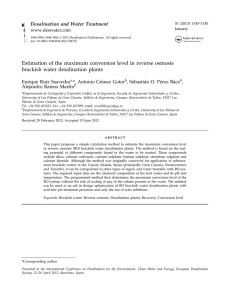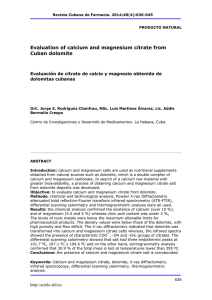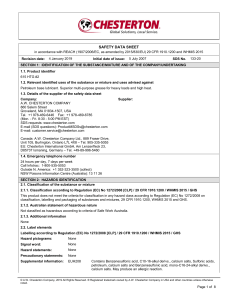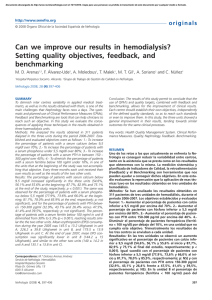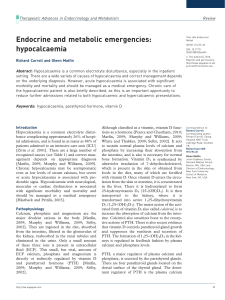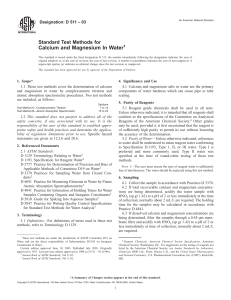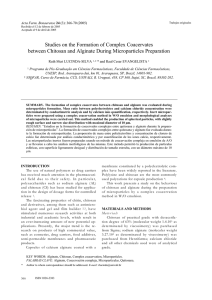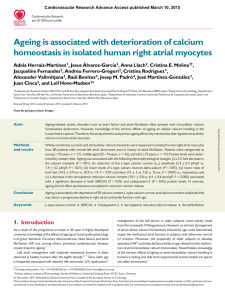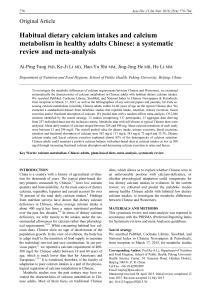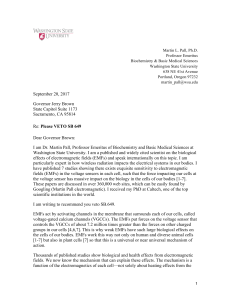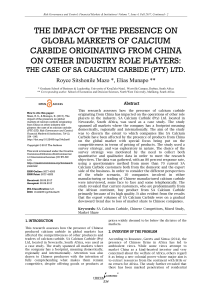Calcium-supplemented University of Wisconsin solution in long
Anuncio
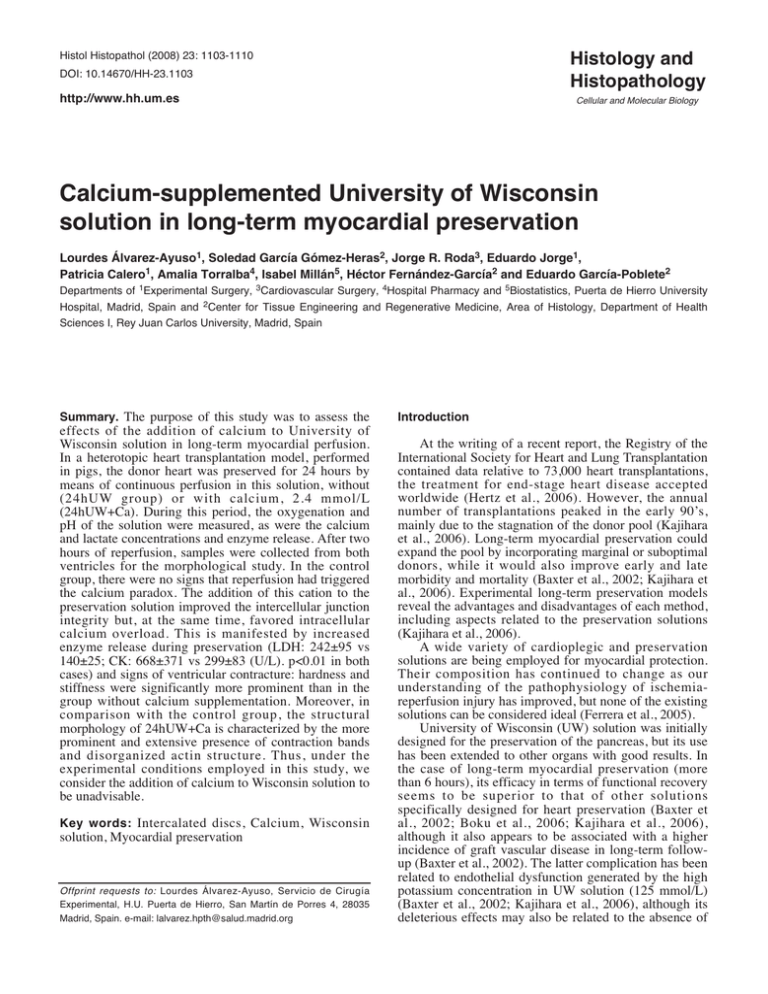
Histology and Histopathology Histol Histopathol (2008) 23: 1103-1110 DOI: 10.14670/HH-23.1103 http://www.hh.um.es Cellular and Molecular Biology Calcium-supplemented University of Wisconsin solution in long-term myocardial preservation Lourdes Álvarez-Ayuso1, Soledad García Gómez-Heras2, Jorge R. Roda3, Eduardo Jorge1, Patricia Calero1, Amalia Torralba4, Isabel Millán5, Héctor Fernández-García2 and Eduardo García-Poblete2 Departments of 1Experimental Surgery, 3Cardiovascular Surgery, 4Hospital Pharmacy and 5Biostatistics, Puerta de Hierro University Hospital, Madrid, Spain and 2Center for Tissue Engineering and Regenerative Medicine, Area of Histology, Department of Health Sciences I, Rey Juan Carlos University, Madrid, Spain Summary. The purpose of this study was to assess the effects of the addition of calcium to University of Wisconsin solution in long-term myocardial perfusion. In a heterotopic heart transplantation model, performed in pigs, the donor heart was preserved for 24 hours by means of continuous perfusion in this solution, without (24hUW group) or with calcium, 2.4 mmol/L (24hUW+Ca). During this period, the oxygenation and pH of the solution were measured, as were the calcium and lactate concentrations and enzyme release. After two hours of reperfusion, samples were collected from both ventricles for the morphological study. In the control group, there were no signs that reperfusion had triggered the calcium paradox. The addition of this cation to the preservation solution improved the intercellular junction integrity but, at the same time, favored intracellular calcium overload. This is manifested by increased enzyme release during preservation (LDH: 242±95 vs 140±25; CK: 668±371 vs 299±83 (U/L). p<0.01 in both cases) and signs of ventricular contracture: hardness and stiffness were significantly more prominent than in the group without calcium supplementation. Moreover, in comparison with the control group, the structural morphology of 24hUW+Ca is characterized by the more prominent and extensive presence of contraction bands and disorganized actin structure. Thus, under the experimental conditions employed in this study, we consider the addition of calcium to Wisconsin solution to be unadvisable. Key words: Intercalated discs, Calcium, Wisconsin solution, Myocardial preservation Offprint requests to: Lourdes Álvarez-Ayuso, Servicio de Cirugía Experimental, H.U. Puerta de Hierro, San Martín de Porres 4, 28035 Madrid, Spain. e-mail: [email protected] Introduction At the writing of a recent report, the Registry of the International Society for Heart and Lung Transplantation contained data relative to 73,000 heart transplantations, the treatment for end-stage heart disease accepted worldwide (Hertz et al., 2006). However, the annual number of transplantations peaked in the early 90’s, mainly due to the stagnation of the donor pool (Kajihara et al., 2006). Long-term myocardial preservation could expand the pool by incorporating marginal or suboptimal donors, while it would also improve early and late morbidity and mortality (Baxter et al., 2002; Kajihara et al., 2006). Experimental long-term preservation models reveal the advantages and disadvantages of each method, including aspects related to the preservation solutions (Kajihara et al., 2006). A wide variety of cardioplegic and preservation solutions are being employed for myocardial protection. Their composition has continued to change as our understanding of the pathophysiology of ischemiareperfusion injury has improved, but none of the existing solutions can be considered ideal (Ferrera et al., 2005). University of Wisconsin (UW) solution was initially designed for the preservation of the pancreas, but its use has been extended to other organs with good results. In the case of long-term myocardial preservation (more than 6 hours), its efficacy in terms of functional recovery seems to be superior to that of other solutions specifically designed for heart preservation (Baxter et al., 2002; Boku et al., 2006; Kajihara et al., 2006), although it also appears to be associated with a higher incidence of graft vascular disease in long-term followup (Baxter et al., 2002). The latter complication has been related to endothelial dysfunction generated by the high potassium concentration in UW solution (125 mmol/L) (Baxter et al., 2002; Kajihara et al., 2006), although its deleterious effects may also be related to the absence of 1104 Calcium-supplemented Wisconsin solution calcium in its composition (Baxter et al., 2002). Calcium is essential to cardiac function. UW solution does not contain this cation, but does contain lactobionate, a powerful calcium complexing agent: the advantage is that this can impede cytosolic calcium overload during hypothermic preservation; the drawback is that, if the depletion is prolonged, it may affect cell cohesion (García-Poblete et al., 1997; Baxter et al., 2002) and, during rewarming and reperfusion, it can facilitate the development of the calcium paradox (Ledingham et al., 1990; Stringham et al., 1994; McKean 2001; Baxter et al., 2002). To prevent the latter from occurring, a great number of authors have recommended adding calcium to the UW solution in studies involving long-term preservation, although there is no consensus as to the optimal concentration, with the proposed levels ranging between 0.1 and 2.5 mmol/L (Ledingham et al., 1990; McGowan et al., 1994; Ohkado et al., 1994; Stringham et al., 1994; Fremes et al., 1995; Michel et al., 2000; Sunamori et al., 2001; Baxter et al., 2002; Michel et al., 2002; An et al., 2003; Ferrera et al., 2005). In a previous study in which the myocardium was preserved in UW solution for 24 hours, our group found that, following reperfusion, most of the intercellular junctions appeared to be open (García-Poblete et al., 1997). Given that these junctions are calcium-dependent, we decided to undertake the present study, the main objective of which was to analyze the morphological changes produced in myocardium when heterotopically transplanted after 24 hours of preservation in UW solution supplemented with calcium. Materials and methods The Institutional Animal Care and Use Committee approved the study. The investigation conformed to the Guide for the Care and Use of Laboratory Animals published by the US National Institutes of Health (NIH Publication No. 85-23, revised 1996). Ten heterotopic heart transplantations were performed in Landrace x Large White pigs (weighing 19 to 22 kg), which were randomly assigned to the following groups: 24hUW (n=6), in which the donor heart was subjected to 24 hours of ischemia, during which the heart, suspended by the aorta, was preserved in a gravity-driven continuous perfusion system (maximum pressure 15 cm H2O) with recirculation of the solution, hypothermia (5°C) and oxygenation (95% O2, 5% CO2) (Wicomb et al., 1984), using University of Wisconsin solution (Viaspan ® ) as the preservation solution (total volume 2L). And 24hUW+Ca (n=4), in which the same procedure was followed, with the exception that calcium, 2.4 mmol/L, was added to the preservation solution. Anesthetic and surgical procedures Donors and recipients were sedated with ketamine (20 mg/kg bw), diazepam (0.1 mg/kg bw) and atropine (0.02 mg/kg bw). Anesthesia was induced with an i.v. bolus of propofol (2 mg/kg bw), midazolam (0.6 mg/kg bw) and fentanyl (5 µg/kg bw). After endotracheal intubation, anesthesia was maintained with continuous i.v. infusion of propofol (9 mg/kg/h), midazolam (0.6 mg/kg/h), fentanyl (5 µg/kg/h) and pancuronium bromide (0.4 mg/kg/h). An Adult Star ® ventilator (Infrasonics, Inc.) was used for mechanical ventilation. Catheters were inserted in right (Swan-Ganz) and left jugular veins, and in the carotid artery for hemodynamic assessment, blood sampling, and drug and serum infusion. In donors, via median sternotomy and following systemic heparinization (3 mg/kg bw), cardiac arrest was induced by injection of a cold (4°C), crystalloid cardioplegic solution (K+=30 mEq/L) through the aortic root. The heart was then excised, including the aorta up to the descending segment. The pulmonary artery was transected at the level of its bifurcation and anastomosed to the left atrial appendage, in order to permit the drainage of the right chambers. After the ischemic period corresponding to each group, heterotopic heart transplantation was carried out according to the technique described by Matsui et al, modified by our group (Matsui et al., 1988; Roda et al., 2004). Inotropic support was not used in any case. Data and sample collection Samples of the preservation solution were collected 10 minutes and 6 and 24 hours after the initiation of continuous perfusion to determine pO 2 , pCO 2 , pH, glucose, lactate, calcium, lactate dehydrogenase (LDH) and creatine kinase (CK). The electrocardiogram and heart rate, mean arterial pressure (mAP), pulmonary artery pressure, pulmonary capillary pressure and central venous pressure were recorded by a PM8060 Vitara monitoring unit (Dräger), and cardiac output (CO) was measured by thermodilution, using a SAT-2 TM monitor (Baxter Healthcare Corporation), at baseline and after 5, 60 and 120 minutes of reperfusion. The systolic pressure of the left ventricle of the transplanted heart (LVs), obtained via apical puncture, was measured after 60 and 120 minutes of reperfusion. Once this phase was concluded, that is to say, after 24 hours of preservation and 2 hours of reperfusion, two samples of 2 cm3 were taken from the free wall of both ventricles for light microscopy and transmission electron microscopy studies. For light microscopy, samples of 5 mm3 were fixed in 10% formaldehyde, embedded in paraffin and cut into 5-micron-thick slices in a Micron HM360 microtome. Sections were stained with hematoxylin-eosin, periodic acid Schiff (PAS), Van Giesson and Azan to evaluate together myocyte glycogen content, contraction bands, necrosis, edema, hemorrhage and fibrosis, studied under a Zeiss Axiophot 2 microscope and photographed by an 1105 Calcium-supplemented Wisconsin solution Axiocam HRc camera. For immunohistochemical studies, sections were deparaffinized and rehydrated before blocking endogenous peroxidase activity with H2O2 (0.3%) in methanol. The slides were rinsed with PBS and incubated with primary antibodies in a moist chamber at room temperature. The primary antibodies used were: Muscle Specific Actin Monoclonal Antibody (A 7811 Novocastra) at a 1:100 dilution, and Desmin Monoclonal Antibody at a 1:50 dilution (DE-R11 Novocastra). Sections were subsequently incubated with biotinylated anti-rabbit IgG and LBA (DAKO) for 25 min at room temperature, rinsed with PBS and immersed for 25 min in avidin peroxidase. The immunostaining reaction product was developed using diaminobenzidine. Counterstain was performed with hematoxylin. The specificity of the immunohistochemical procedure was checked by incubation of sections with nonimmune serum instead of primary antibody. For the ultrastructural study, samples were cut into ≤ 1mm 3 blocks and immersed for 2 hours in 2% phosphate buffered glutaraldehyde. They were then washed in phosphate buffer and postfixed with 2% osmium tetroxide for 1 hour. After dehydration in a graded acetone series, they were embedded in Spurr, cut into semithin slices (5.5-1 µm thick) using a Leika Ultracut R ultramicrotome, and stained with Richardson´s methylene blue for light microscopy study. Likewise, ultrathin slices (70 nm thick) were stained with a water-based solution of 2% uranyl acetate and lead citrate for study under a JEOL (JEM-1010) electron microscope. For each group of studies (light microscopy, immunohistochemical and ultrastructural), samples were evaluated by a single pathologist who was blind to the details of each specimen. Statistical analysis Descriptive variables (mean, standard deviation and range) were calculated for each quantitative variable. The hypothesis of a normal distribution was verified using the Kolmogorov-Smirnov test. To assess the differences in the variables according to duration of ischemia and group, repeated measures analysis of variance (ANOVA) were applied, followed by the Student-Newman-Keuls test for multiple comparisons. Those results with a p value of less than 0.05 were considered significant. Results Functional findings During the ischemic period, the following changes took place in the preservation solution (Table 1): There were significant increases in pO2 and pCO2 and a significant decrease in pH, although there were no differences between the two groups. The glucose concentration increased progressively in both groups. Taking into account the fact that UW solution does not contain glucose, its presence and its increase could be indicative of myocardial glycogen degradation in order to maintain anaerobic glycolysis as a source of energy. The increase in the lactate concentrations would be consistent with this hypothesis. The calcium concentrations detected in UW solution, which theoretically does not contain this cation, may be due to contamination, although it is necessary to keep in mind that the levels are far below the range of sensitivity of the method employed for determination. The addition of calcium, 2.4 mmol/L, to UW solution produced an average increase in the concentration of 0.125 mmol/L, which remained stable throughout the 24 hours of perfusion. In the 24hUW+Ca group, the increase in the enzyme levels was approximately two-fold greater than that observed in the 24hUW group and, at the end of the ischemic period, the ventricular hardness and stiffness Table 1. Changes in the preservation solution during continuous hypothermic (5°C) oxygenated perfusion. pO2 (mmHg) 10 min 6h 24 h 24hUW 160±80 353±107 ** 609±56 ** 24hUW+Ca 192±80 431±65 ** 565±88 ** pCO2 (mmHg) 10 min 6h 24 h 2.4±0.5 5.2±1.9 ** 14.9±1.2 ** 3.1±2.5 9.5±7.8 ** 16.5±1.7 ** Glucose (mg/dl) 10 min 6h 24 h 6.6±4.8 11.8±3.8 ** 28±6.3 ** 3.4±2.0 15.2±8.4 ** 34.7±13.7 ** pH 10 min 6h 24 h Lactate (mmol/L) 10 min 6h 24 h Calcium (mmol/L) 10 min 6h 24 h LDH (U/L) 10 min 6h 24 h CK (U/L) 10 min 6h 24 h 7.64±0.13 7.42±0.14 ** 7.11±0.05 ** 0.30±0.16 0.57±0.19 ** 0.57±0.35 * 0.375±0.075 0.350±0.125 0.325±0.125 11±7 24±8 * 140±25 ** 11±7 55±14 299±83 ** 7.56±0.16 7.27±0.13 ** 7.11±0.04 ** 0.37±0.26 0.69±0.09 ** 0.34±0.13 0.475±0.075 ‡ 0.475±0.05 ‡ 0.525±0.05 ‡ 11±10 53±34 † 242±95 ** ‡ 15±15 140±102 † 668±371 ** ‡ *: p<0.05; **: p<0.01 vs 10 min; †: p<0.05; ‡: p<0.01 vs 24hUW; LDH: lactate dehydrogenase; CK: creatine kinase. 1106 Calcium-supplemented Wisconsin solution were very evident, indicating contracture and greater cell damage than in the group without calcium supplementation. During the initial minutes of reperfusion, the heartbeat was recovered in all the hearts, either spontaneously or by applying electric shock, and the cardiac rhythm was stabilized in about 5 minutes. There were no significant differences between the groups with respect to the hemodynamic status (Table 2). Morphological findings The different techniques (light microscopy, immunohistochemical and ultrastructural) provided us an overall view of the myocardial alterations originated by ischemia-reperfusion, obtaining the following fundamental findings (Table 3). In the small and medium-sized vessels of the vascular tree (Fig. 1), we observed vasoconstriction, which was more marked in the calcium group, as well as adhesion of leukocytes to the vascular endothelium, Table 2. Hemodynamic parameters. mAP (mmHg) Baseline 5 min 60 min 120 min CO (L/min) Baseline 5 min 60 min 120 min LVs (mmHg) 60 min 120 min 24h UW 24h UW+Ca 77±8 64±8 69±6 57±17 77±9 68±2 76±23 69±23 2.4±0.5 1.9±0.5 2.0±0.4 1.8±0.3 3.4±1.3 2.6±1.0 2.6±0.9 2.6±0.8 67±10 52±10 69±14 64±20 more evident in postcapillary venules and small veins, producing the phenomenon of transmigration (Fig. 2). Interstitial edema with inflammatory infiltrate and hemorrhage were also observed, and were more prominent in the hearts perfused with the calciumsupplemented solution (Fig. 3). Within the cells, we detected the presence of circumscribed areas of necrosis, which affected the 24hUW+Ca group to a greater degree. There were thick, transverse, irregular bands that were more intensely stained. Ultrastructurally, they were formed by the contraction of disorganized sarcomeres, with thickened Z-lines, coexisting with other elongated lines adjacent to Fig. 1. Vasoconstriction in a small myocardial vessel observed in a case of the 24hUW+Ca group. EM, x 20000 mAP: mean arterial pressure. CO: cardiac output. LVs: left ventricular systolic pressure. Table 3. Structural damage produced after 24 hours of preservation and 2 hours of reperfusion. Comparison between the preservation solutions. Vasoconstriction Adhesion of leukocytes Edema. Inflammatory infiltrate. Hemorrhage. Mitochondrial degenerative changes Necrosis Contraction bands Loss of the actin pattern Alteration of the intercalated discs + Mild. ++ Moderate. +++ Severe. 24hUW + + ++ ++ + +/++ + ++ 24hUW+Ca +++ ++ +++ ++ ++ +++ ++/+++ + Fig. 2. Transmigration in a postcapillary venule in a case of the 24hUW+Ca group. Semithin, x 1000 Calcium-supplemented Wisconsin solution the former, forming contraction bands (Fig. 4). Discontinuities in the sarcolemma and mitochrondrial changes were observed among the bands. In both groups, nearly 50% of mitochondria presented mild or moderate changes (reduction in the density of the matrix and 1107 moderate disruption of cristae), and less frequently general swelling, disappearance of the cristae and the presence of dense amorphous structures. It is interesting to note that these changes were circumscribed to more or less extensive areas of the Fig. 3. Interstitial edema with inflammatory cell infiltrate. A vein showing cell adhesion to the endothelium can be observed in a heart perfused with the calcium supplemented solution. H-E, x 400. Fig. 4. Ultrastructure of myocytes of the 24hUW+Ca group in which contraction bands are forming. As a consequence, the adjacent sarcomeres are elongated. EM, x 8000. Fig. 5. This figure shows two adjacent myocytes of the 24hUW+Ca group. That on the left has undergone changes, with contraction bands and zones of disorganized structure, while that on the right exhibits a nearly normal structure. EM, x 5000 1108 Calcium-supplemented Wisconsin solution Fig. 6. Immunohistochemical labeling for actin. A. 24hUW group: a higher proportion of actin is preserved and the necrotic zones are less extensive than in the calcium group. B. 24hUW+Ca group: extensive areas of necrosis are observed, with loss of anti-actin positivity. PAP anti-actin, x 200 Fig. 7. Intercellular junctions. A. 24hUW group: An intercalated disc with a disorganized and elongated structure. B. 24hUW+Ca group: Structure is better preserved in this group. EM, x 25000 Calcium-supplemented Wisconsin solution cardiac tissue, and normal myocytes could even be found adjacent to others that were severely altered (Fig. 5). In the 24hUW group, following labeling with antiactin antibodies, we observed the loss of these intermediate filaments, alternating with zones of preserved positivity that conformed to the normal pattern (Fig. 6A). In contrast, in the 24hUW+Ca group, there was a much more extensive loss of the normal actin pattern, which was reduced to amorphous clusters scattered throughout the myocyte cytoplasm (Fig. 6B). Both the structural and ultrastructural studies revealed a marked decrease in the amount of glycogen. As happened with anti-desmin immunohistochemical labeling, electron microscopy showed severe disruption of the junction complexes in hearts perfused in the absence of calcium (Fig. 7A), whereas in the 24hUW+Ca group the intercellular junctions were better preserved (Fig. 7B). Discussion UW solution contains high-energy phosphate precursors (adenosine and phosphate), impermeants (lactobionate and raffinose), an oncotic agent (pentafraction), and antioxidants (allopurinol and glutathione). The purpose of these components is to preserve adenosine triphosphate (ATP), reduce intracellular and extracellular edema, and attenuate freeradical-mediated injury. Given its ionic composition, it is an intracellular solution: the high K+ concentration (125 mmol/L) produces immediate electromechanical arrest, while the low Na+ concentration (20 mmol/L), together with the absence of Ca2+, predisposes to the calcium paradox during reperfusion (Ledingham et al., 1990; Starr et al., 1999; Baxter et al., 2002; Michel et al., 2002; Boku et al., 2006). This phenomenon does not appear to occur with ischemia times of 6 hours or less, perhaps due to the action of hypothermia, the pH of the solution and the practically unavoidable contamination of the latter by traces of calcium (Ledingham el al., 1990; Stringham et al., 1994; An et al., 2003). On the other hand, it has been reported that prolonged calcium depletion, in addition to favoring the triggering of the calcium paradox during rewarming and reperfusion (Ledingham et al., 1990; Stringham et al., 1994; McKean 2001; Baxter at al., 2002), can affect the cell surface and, in particular, cell cohesion (Baxter et al., 2002). In a previous study carried out in dogs, our group confirmed this fact: although at the end of ischemia, the aspect of the myocardium was practically normal, following reperfusion, the vast majority of intercellular junctions presented wide cleft separations and loss of structure of the filaments involved in binding (García-Poblete et al., 1997). In this study, although the involvement of the intercellular junctions in the 24hUW group was not as prominent as in the aforementioned report, it was more marked than in the 24hUW+Ca group. In the final outcome, after ischemia-reperfusion, a 1109 number of factors intervene: in addition to the type of organ, preservation method, ischemia time, temperature, oxidative damage and calcium overload, the species and age of the donor and recipient also play a role (McGowan et al., 1994). Although the preservation and reperfusion conditions in the two studies are analogous, the experimental animals are not: aside from the possible differences between the species, the utilization of pigs ensures greater homogeneity with respect to age, a circumstance that was not possible to the same extent when dogs were employed. The presence of lactobionate, a calcium chelator, in the UW solution means that its addition at micromolar concentrations is insufficient (Stringham et al., 1994), but the optimal concentration has yet to be established. Different authors have recommended supplementing UW solution with concentrations that range between 0.1 and 2.5 mmol/L, although they incorporated other additives (magnesium, histidine, butanedione monoxime) and/or modified the sodium-to-potassium ratio of the original solution (Ledingham et al., 1990; McGowan et al., 1994; Ohkado et al., 1994; Stringham et al., 1994; Fremes et al., 1995; Michel et al., 2000; Sunamori et al., 2001; Baxter et al., 2002; Michel et al., 2002; An et al., 2003; Ferrera et al., 2005), making it extremely difficult to compare these studies, although the conclusion in every case is that the addition of calcium had beneficial effects on myocardial function. According to this information, in our study we selected a high calcium concentration without exceeding the limit considered harmful. Our findings were in complete disagreement with those of these groups, resembling much more closely those of Ben Abdennebi et al. (2001), despite the fact that the latter study was performed in rat liver preserved in UW solution with the sodium-to-potassium ratio reversed and supplemented with calcium at a concentration of 0.5 mmol/L. In our study, we observed that, during the preservation period, in the group in which UW solution was supplemented with calcium, the increase in enzyme release was approximately two-fold greater than in the control group, suggesting greater cell damage; moreover, the hardness and stiffness detected in the ventricular walls prior to implantation were suggestive of ATP depletion and calcium accumulation in the myocyte, a situation that favors necrosis (Sunamori et al., 2001). The results of the histological study carried out after 2 hours of reperfusion were consistent with previous descriptions: the cell damage was much more prominent and extensive than in the control group. The appearance of necrosis in contraction bands has been reported to be a characteristic sign of infarction followed by reperfusion (Rubin et al., 2005): these thick, transverse, irregular, eosinophilic bands appear in the necrotic myocytes and, ultrastructurally, are formed by small groups of supercontracted and disorganized sarcomeres with thickened Z-lines. Although no significant differences were detected between the groups with respect to the hemodynamic 1110 Calcium-supplemented Wisconsin solution status, it should be taken into account that the study only involves the first two hours of reperfusion; if it had been prolonged, the changes in the cells in the 24hUW+Ca group indicate that the outcome would have been worse than in the controls. The intracellular calcium overload in long-term myocardial preservation with UW solution was more hypothetical than real in our study. In contrast, the addition of this cation produced extraordinarily severe cell damage, even though the intercellular junctions were better preserved. Thus, under the experimental conditions described here, we consider the addition of calcium to UW solution to be unadvisable, if not contraindicated. Acknowledgements. This study has been financed by grant no. 00-0387 from the FIS, Spain. The authors wish to thank Julio Paredes, Antonio Márquez and Raquel Franco, lab technicians, for their help in processing the histological samples, and M. Messman for her translation of the text. References An J., Camara A.K., Chen Q. and Stowe D.F. (2003). Effect of low [CaCl2] and high [MgCl2] cardioplegia and moderate hypothermic ischemia on myoplasmic [Ca2+] and cardiac function in intact hearts. Eur. J. Cardiothorac. Surg. 24, 974-985. Baxter K., Howden B.O. and Jablonski P. (2002). Pretransplant rinse of hearts preserved with colloid-free UW solution and more effective heart preservation: studies in a rat abdominal heart transplant model. Transplantation 73, 23-31. Ben Abdennebi H., Steghens J.P., Hadj-Aissa A., Barbieux A., RamellaVirieux S., Gharib C. and Boillot O. (2002). A preservation solution with polyethylene glycol and calcium: a possible multiorgan liquid. Transpl. Int. 15, 348-354. Boku N., Tanoue Y., Kajihara N., Eto M., Masuda M. and Morita S. (2006). A comparative study of cardiac preservation with Celsior or University of Wisconsin solution with or without prior administration of cardioplegia. J. Heart Lung Transplant. 25, 219-225. Ferrera R., Michel P. and Ovize M. (2005). Paradoxical toxicity of cardioplegic compounds on ischemic cardiomyocyte using optimal design strategy. J. Heart Lung Transplant. 24, 904-911. Fremes S.E., Zhang J., Furukawa R.D., Mickle D.A. and Weisel R.D. (1995). Cardiac storage with University of Wisconsin solution, calcium, and magnesium. J. Heart Lung Transplant. 14, 916-925. García-Poblete E., Fernández H., Álvarez-Ayuso L., Torralba A. and Escudero C. (1997). Structural and ultrastructural study of the myocardium after 24-hour preservation in University of Wisconsin solution. Histol. Histopathol. 12, 375-382. Hertz M.I., Boucek M.M., Edwards L.B., Keck B.M., Rowe A.W., Taylor D.O., Trulock E.P. and Waltz D.A. (2006). The ISHLT transplant registry: Moving forward. J. Heart Lung Transplant. 25, 1179-1185. Kajihara N., Morita S., Tanoue Y., Boku N., Eto M., Nishida T. and Tominaga R. (2006). The UW solution has greater potential for longer preservation periods than the Celsior solution: comparative study for ventricular and coronary endothelial function after 24-h heart preservation. Eur. J. Cardiothorac. Surg. 29, 784-789. Ledingham S.J.M., Katayama O., Lachno D.R. and Yacoub M. (1990). Prolonged cardiac preservation. Evaluation of the University of Wisconsin preservation solution by comparison with the St. Thomas’ Hospital cardioplegic solutions in the rat. Circulation 82 (suppl IV), IV-351–IV-358. Matsui Y., Deleuze P., Kawasaki K., Leandri J. and Loisance D. (1988). Experimental model of heterotopic cardiac transplantation for evaluation of graft viability and function. Eur. Surg. Res. 20, 161167. McGowan F.X. Jr., Cao-Danh H., Takeuchi K., Davis P.J. and del Nido P.J. (1994). Prolonged neonatal myocardial preservation with a highly buffered low-calcium solution. J. Thorac. Cardiovasc. Surg. 108, 772-779. McKean T.A. (2001). Calcium transport mechanisms in muskrat and rat hearts. Comp. Biochem. Physiol. A: Mol. Integr. Physiol. 130, 771780. Michel P., Hadour G., Rodriguez C., Chiari P. and Ferrera R. (2000). Evaluation of a new preservative solution for cardiac graft during hypothermia. J. Heart Lung Transplant. 19, 1089-1097. Michel P., Vial R., Rodriguez C. and Ferrera R. (2002). A comparative study of the most widely used solutions for cardiac graft preservation during hypothermia. J. Heart Lung Transplant. 21, 1030-1039. Ohkado A., Cao-Danh H., Sommers K.E. and del Nido P.J. (1994). Evaluation of highly buffered low-calcium solution for long-term preservation of the heart. Comparison with University of Wisconsin solution. J. Thorac. Cardiovasc. Surg. 108, 762-771. Roda J.R., Álvarez-Ayuso L., Téllez G., Cañas A., Castedo E., Ugarte J. and Castillo-Olivares J.L. (2004). Experimental heterotopic heart transplantation: An easier technique. Eur. Surg. Res. 36, 64-66. Rubin E., Gorstein F., Rubin R., Schwarting F. and Strayer D. (2005). In: Rubin: Patología estructural. Fundamentos clínicopatológicos en medicina. 1st ed. Rubin E., Gorstein F., Rubin R., Schwarting F. and Strayer D. (eds). McGraw-Hill Interamericana. Madrid. pp 478532. Starr J.P., Jia C.X., Amirhamzeh M.M., Rabkin D.G., Hart J.P., Hsu D.T., Fisher P.E., Szabolcs M. and Spotnitz H.M. (1999). Coronary perfusate composition influences diastolic properties, myocardial water content, and histologic characteristics of the rat left ventricle. Ann. Thorac. Surg. 68, 925-930. Stringham J.C., Paulsen K.L., Southard J.H., Mentzer R.M. Jr. and Belzer F.O. (1994). Prolonging myocardial preservation with a modified University of Wisconsin solution containing 2,3butanedione monoxime and calcium. J. Thorac. Cardiovasc. Surg. 107, 764-775. Sunamori M., Shimizu M., Tabuchi N., Arai H. and Tanaka H. (2001). The use of a nondepolarizing cardioplegic solution for cardiac preservation has a beneficial effect on the left ventricular diastolic function. Transpl. Int. 14, 72-79. Wicomb W.N., Cooper D.K.C, Novitzky D. and Barnard C.N. (1984). Cardiac transplantation following storage of the donor heart by a portable hypothermic perfusion system. Ann. Thorac. Surg. 37, 243248. Accepted March 26, 2008
